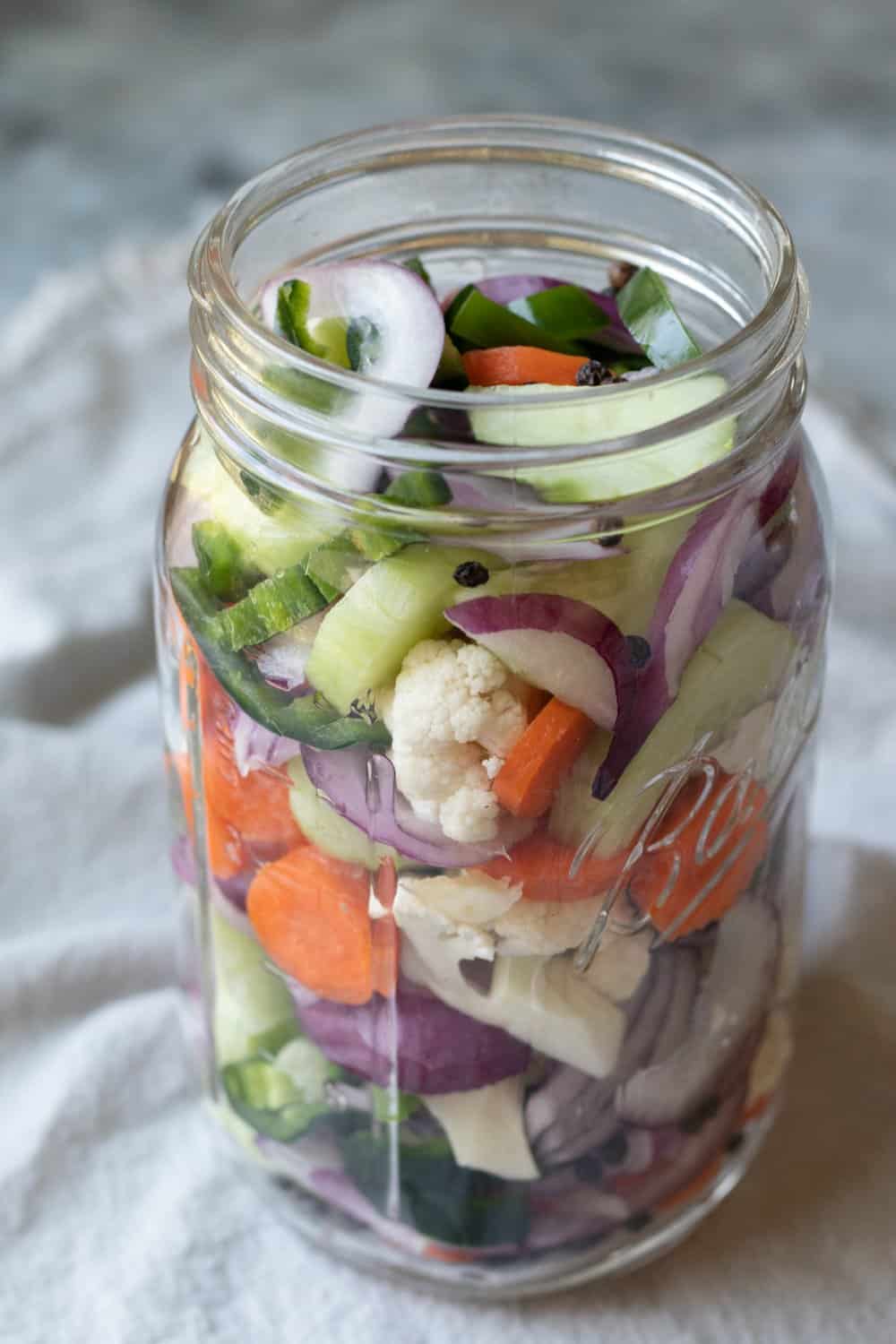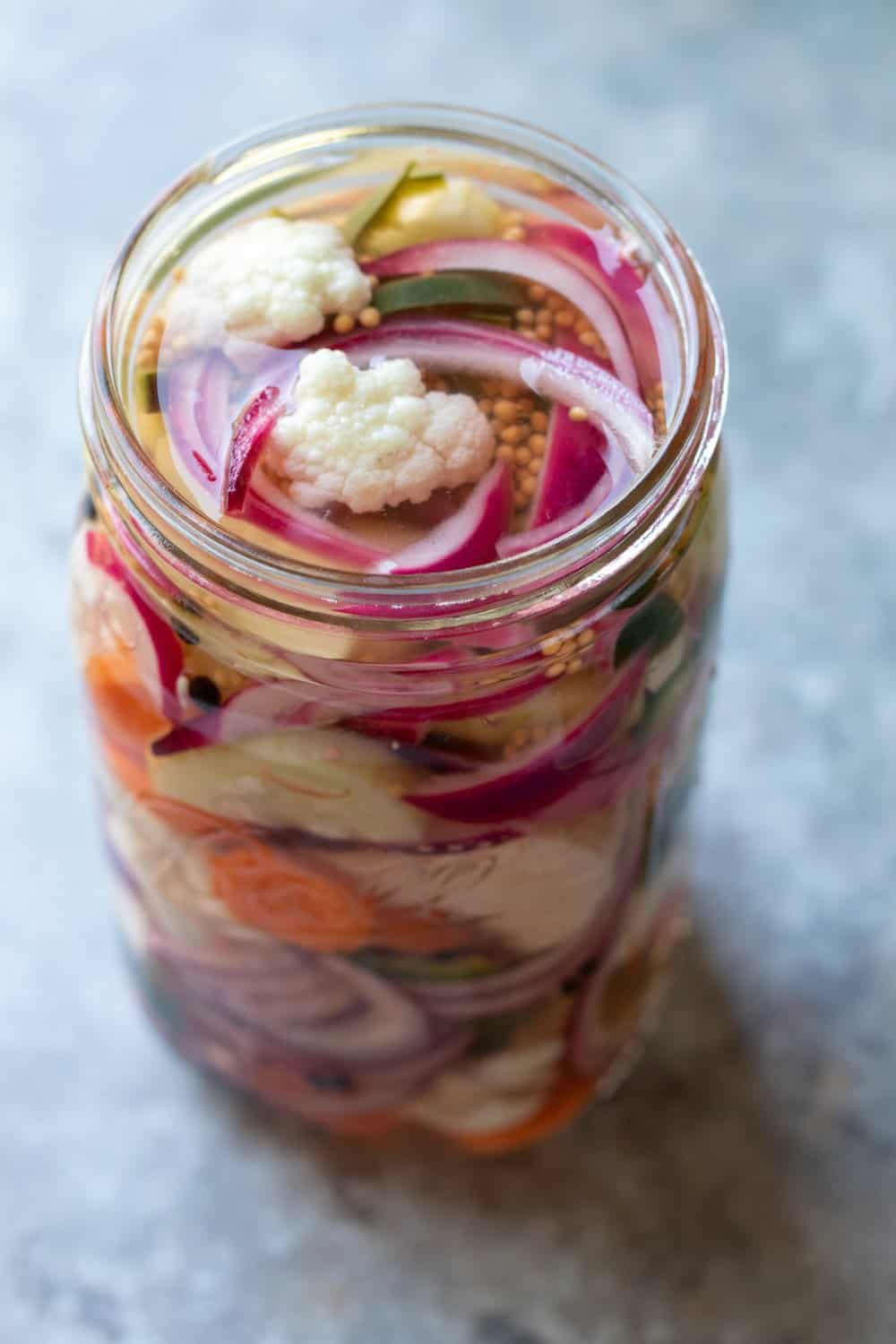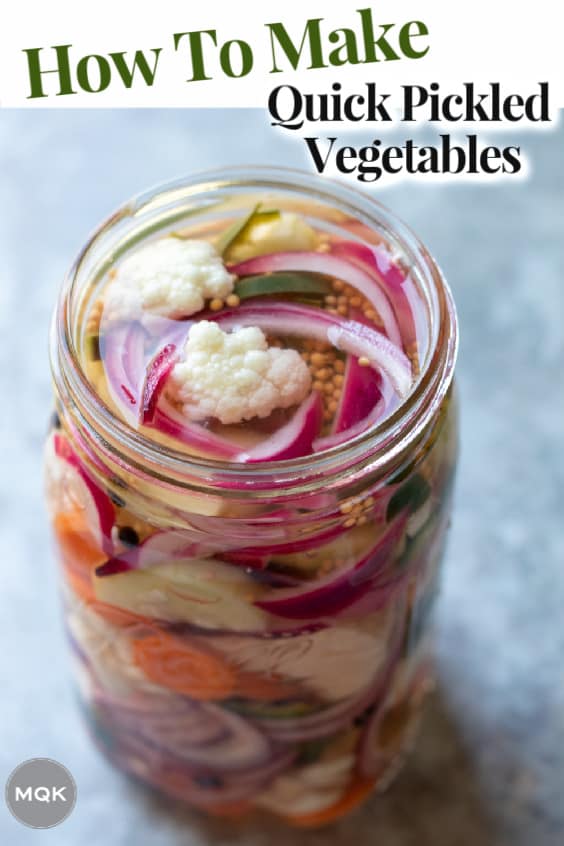Quick Pickled Vegetables, also known as refrigerator pickles, are endlessly versatile and an easy way to preserve fresh veggies. Create a fun mixture using the vegetables you have on hand, or pickle individual varieties in their own jars. Try cauliflower, jalapeños, red onion, green beans, asparagus, radishes, and so much more.
These tangy, crisp, slightly sweet pickles are guaranteed to elevate your salads, sandwiches, snack boards, and stir fries!

I've been a bit obsessed with quick pickled vegetables this summer. From sandwiches and tacos to lettuce wraps and pizza, it's difficult to think of a dish that doesn't benefit from their exciting burst of salt and tang!
Not only are quick pickles delicious, they're also an easy way to preserve fresh produce when you find yourself with extra from the garden, grocery store, or farmers market.
And making quick pickled vegetables couldn't be easier! I'll show you step by step how to do it. First, a note about pickled jalapeno...
Jump to:

Our jalapeño plants have grown especially well this year and created far more peppers than we could use or give away. On top of having an abundance of them, these peppers are HOT. Like, really, really spicy.
Having made quick pickled jalapeños before, I thought I'd be clever and use loads of them that way.
But it took just one batch for me to learn my lesson. The jalapenos were much too spicy to pickle on their own.
I realized that most, if not all, of the seeds in the jalapeños would have to be removed and that combining the peppers with other veggies was the way to go.
But hey, it all worked out because combining different vegetables creates a more interesting combination of deliciously tangy, spicy, and crunchy vegetables anyway! They're perfect for snacking and garnishing any meal.
Now, if you're a SUPER fan of all things spicy, and your jalapenos don't seem to be extraordinarily hot, you may find success with a batch of quick pickles comprised of mostly peppers (and their seeds). The spiciness of jalapenos can vary quite a bit, so that's a major factor.
The blend of cauliflower, carrots, red onion, cucumber, and jalapenos pictured below was SO GOOD we devoured half the jar in one day.
Of course, only using 3 or 4 jalapeños per jar wasn't going to use up the massive pile of jalapenos I had on my hands, but it was a start.
Quick pickled vegetables will keep in the fridge for several weeks, so I plan to make a jar or two each week until our jalapenos are gone (and share some jars, too). Roasting the jalapenos has been another delicious way to them. You can also freeze jalapenos.

What You'll Need
As I mentioned, the recipe is very versatile, so don't be afraid to try different vegetables and spices. You can also use any combination of the vinegars listed below. Here are the basic ingredients you'll need:
Pickling Brine Ingredients
- 1 cup white distilled vinegar
- ¼ cup rice vinegar or apple cider vinegar
- 1 ¼ cups water
- 2 teaspoons sea salt
- 1 tablespoon sugar
Vegetables
Amounts will vary depending on the vegetables you use (due to negative space while measuring) but aim for about 3 to 4 cups of chopped/sliced vegetables.
Some of our favorites are:
Want to save this recipe? 📩
Keep an eye out for more delicious recipes. Unsubscribe anytime.
- red onion
- cauliflower
- carrots
- jalapenos
- cucumbe,
- radishes
- beets
- green beans and asparagus are also fun but benefit from blanching first. The other veggies can go into the jar raw.
In the jar pictured here, I used the following:
- about ¼ small head of cauliflower, cut into bite-size florets
- 1 medium carrot, peeled, cut into coins
- 1 pickling cucumber, peeled and cut into coins (peeling optional)
- ½ large red onion, thinly sliced
- 3 jalapeños, sliced lengthwise, seeded, then sliced again
- 3 cloves garlic, smashed and sliced
Flavorings
- 2 teaspoons whole black peppercorns
- 2 teaspoons mustard seeds
You can also get creative with herbs and spices. Here are a few ideas:
- fresh or dried cilantro, dill, or rosemary
- dried spices such as red pepper flakes, paprika, and ground turmeric
- fresh turmeric and ginger root
For my next batch of quick pickles I plan to do a ginger-turmeric combo with mostly rice vinegar. Doesn't that sound delicious?

How To Make Quick Pickled Vegetables
The process for quick pickles is very simple. Some recipes call for briefly heating the vegetables in the brine, but I prefer to put the raw vegetables directly in the jar.
- Fill a wide-mouth 32 ounce glass jar (or 2 pint jars) with the washed and cut veggies and your desired seasonings (peppercorns, mustard seeds, etc).
- Combine the brine ingredients in a small sauce pan and cook over medium-high heat just until it reaches a low boil. Stir and cook for a few seconds to dissolve the sugar.
- Pour the hot brine into the jar so that all of the veggies are covered and liquid almost reaches the top.
- Allow the jar to cool for a few minutes before covering it. Then let it rest on the counter until it has cooled to room temperature. Transfer the jar to the refrigerator.
Your quick pickles will be cold, crisp, delicious, and ready to eat the next day.... if you can wait that long. I can never resist sneaking a few test bites later that same day.
Tip: Quick pickles taste best after at least 2 days in the fridge.
Do I have to use sugar in quick pickle brine?
Technically you don't have to include sugar in the quick pickle brine, but a small amount of added sugar does improve the overall flavor. It's not enough to make these taste like sweet pickles, so don't worry about that! It's just enough to soften and round out the acidity and enhance the flavor.
How to Store Pickled Vegetables
Quick pickles will keep in the refrigerator for 3 to 4 weeks, possibly longer if unopened. Keep in mind that quick pickles are just that, quick and easy! These are not canned or intended for long-term storage. Always keep quick pickled vegetables refrigerated.

Variation - Fruit
Did you know you can also quick pickle fruit? You absolutely can and the results are amazing! Try berries, peaches, apples, mango, pears, plums, and grapes.
For full details and tons of ideas check out the recipe here: Pickled Fruit
Imagine the delicious combinations, like pickled peaches or strawberries on vanilla ice cream, cake, or pancakes. They also add interest to cocktails, mocktails, and milkshakes!
You Might Like
I hope you enjoy these super easy quick pickled vegetables and the extra burst of flavor they add to your meals! If you try the recipe I would love to hear from you.
Comment below, rate the recipe, and be sure to let us know what flavor combinations you try!
Recipe

Quick Pickled Vegetables
Ingredients
- 1 medium carrot, peeled, cut into coins or matchsticks
- ¼ head cauliflower, cut into small florets
- ½ large red onion, thinly sliced
- 1 medium pickling cucumber, peeled, cut into coins or thinly sliced
- 3 to 4 jalapenos, ends trimmed and seeds removed if very hot, sliced
- 2 to 3 cloves garlic, smashed and sliced
- 2 teaspoons whole peppercorns, optional
- 2 teaspoons whole mustard seeds, optional
For the brine:
- 1 cup white distilled vinegar
- ¼ cup rice vinegar or apple cider vinegar
- 1 ¼ cups water
- 2 teaspoons sea salt
- 1 tablespoon sugar
Instructions
- Locate one 32 ounce glass jar (or two pint jars) with a lid. Make sure the jar is clean by pouring a small amount of white vinegar inside, screwing on the lid, and shaking for a few seconds. Let stand for about a minute, then rinse. (There's nothing scientific about this; it's just a simple step I take to improve the cleanliness of the jars.)
- Fill the jar with the prepared vegetables and any flavorings you're using, such as peppercorns, garlic, mustard seeds, and fresh or dried herbs. Set aside.
- In a small sauce pan combine the vinegars, water, salt, and sugar, and cook over medium-high heat until boiling. Stir to dissolve the sugar and salt. Pour the brine into the jar so that it covers the vegetables and almost reaches the top of the jar. Let it cool down for a few minutes, then screw on the lid. Once the jar has cooled to room temperature, transfer it to the refrigerator. The quick pickles can be eaten anytime but taste best after at least one day in the refrigerator.
Notes
Estimated Nutrition (per serving)
Nutrition information is an estimate and will vary depending on the exact amounts and specific products and ingredients used.









Margot says
I made this recipe a few weeks ago using the same ingredients that you suggested. The Quick Pickles make a fantastic side dish with cold salads & vege burgers. I love the way the red on the onion skins slightly tints the vinegar brine and the cauliflower pieces a pretty pink.
I hope things are getting better at your home after Hurricane Helene. I read your email about your experiences. I was so glad your neighbours and their dog survived their home being washed off its foundations!
Maxine says
I've been trying to find a recipe like this for so long! I'm trying to eat healthier but found many hurdles along the way: fresh fruit and veggies spoil quicker where I live, and because I live in Latin America water-bath canning and pickling salt are luxuries. I'm on a medically-ordered low-carb diet so the cups of sugar other recipes use were a no-no. I've been depending on frozen fruit and veggies but I missed fresher food, my probiotics and the FLAVOUR. I'll be pickling the morning away! Thank you!
Pam says
Made these over the weekend and they’re so good! Just right. Thank you for sharing your recipe with us 🙂
Pamela says
So good! Easy healthy snack in the fridge that already ready!
Donna Walsh says
Can these be canned for gift giving?
Lori Rasmussen says
Hi Donna - For food safety reasons I recommend following a recipe written specifically for canning.
Wendi says
Simple, delicious and just what I was looking for. Thanks!!
Leah P says
Delicious! Turned out crisp and perfect - right now it’s making my weekday lunch more fun! I did carrot, garlic, thinly sliced cauliflower stalk and a squeeze of hot sauce.
Brenda Uldrick says
Next time try adding some red pepper flakes to the jar if you like a little heat!!
Joe says
Made this and it’s delicious
Kim says
Hi Lori I am wondering why people don’t use broccoli in pickled veggies. I’ve read thru several recipes and none use broccoli
Lori says
Hi Kim, great question!
You definitely can pickle broccoli but since the stems are tough, I think a lot of people shy away from it because it requires a quick steaming or blanching first.
Jenn says
Hi Lori, after looking up hundreds of different recipes, I think I've got a winner in yours and want to try this out tomorrow! However, I do have a quick question. Can you please confirm this recipe isn't a "sweet pickles" recipe? I see that the recipe calls for a bit of sugar. I'm just afraid it will make the final product even a little sweet - I'm not a fan of sweet pickles at all, and don't want to jump into making a full batch and have a bunch of sweet pickled vegetables that'll go to waste (it's happened before!). Thank you!! 🙂
Lori says
Hi Jenn,
The end result definitely isn't as sweet as an actual "sweet pickle," but it does have a hint of sweetness. The sugar is there to balance the vinegar, but if you strongly dislike any sweetness in pickles, it may still be too sweet for you. Do you recall how much sugar was in the previous recipes you tried?
I wouldn't omit the sugar altogether, but you could try reducing it by half. If you give that a try let us know!
John says
Hi Lori, it's me again with probably another dumb question. Can I water bath these jars for long time storage?
Lori says
Hi John, not a dumb question at all! 🙂 For food safety reasons I recommend following a recipe written with canning/longer storage in mind. There will likely be some helpful tidbits in the instructions and the brine may be different, too. This one is best just for quick "refrigerator" pickles.
John says
Ok, Thank You.
Gloria Owings says
5 very tasty
John says
What does the sugar do in this recipe and can I omit it?
Lori says
Hi John, the sugar balances the overall flavor and complements the vinegar. If completely omitted the quick pickles may seem too tart and sour, but you can always give it a try!
Lynn says
Anyone do purple cabbage w/ this recipe?